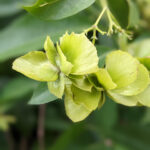Botanical Name/Etymology: Amaranthus hypochondriacus
Family Name: Amaranthaceae
The word Amaranth comes from Greek amaratus, meaning “never fading” – referring to the everlasting bloom. Over 60 varieties worldwide.
Other Varieties of Note: A. caudatus, A. cruentus, A. tricolor, and A retroflexus.
Plant Description: Annual. 3-8 feet tall. Dicot (broadleaf) plants with thick stems (similar to sunflowers). Single erect large flower head composed of spikes. Flowers can be red or green. Leaves are elliptical. The seed is white or black. The growth habit is erect.
Geographic Region: Grows on 5 of 7 continents. Thought to have originated in Central America according to archaeological findings.
Cultivation: Sow seed early summer (after frost). Seeds need 70 degrees for germination. Grows in all soil types, drought conditions (once established), and disturbed soils. Likes heat. The seeds are widely dispersed (considered invasive in some areas). Blooms in late summer.
Folklore: Amaranth was used in ceremonial practices in Mexico – shaped into images of the gods and eaten as communion using human blood as glue to hold the grains together. The Spanish (Cortez and his conquistadors) associated amaranth with pagan practices, so they ordered all fields to be burned and no consumption of amaranths was allowed. To the natives amaranth was known as the “grain of the gods” and it was a staple in their diet for thousands of years. It has been found in Aztec burial mounds that are 6,000 years old.
Uses: Amaranth is a versatile plant – used both as a vegetable (potherb) using the leaves and stems and as a grain. It is also used as a dye plant (red dye) and for ceremonial purposes. Today the leaves and seeds are still key ingredients in Mexican cuisine, widely cultivated, and a valuable cash crop worth four times more than corn (www.mexconnect.com).
Nutrition:
-contains more protein than other grains
-high in amino acids, including lysine
– high in calcium
-more magnesium than other grains
-more iron, folic acid, and fiber
-supplies 75-82% of the nutritional requirements for humans
Medicinal: The Cherokee (North American) used the foliage to reduce hemorrhaging, reduce diarrhea, and treat ulcerated wounds. King’s American Dispensatory lists Amaranthus hypochondriacus as an astringent. (www.texasbeyondhistory.net)
Sara Holland
It is the policy of The Herb Society of America not to advise or recommend herbs for medicinal or health use. This information is intended for educational purposes only and should not be considered as a recommendation or an endorsement of any particular medical or health treatment.









